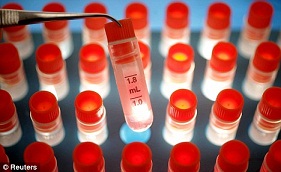Stable and transient transfections share the same basic concepts and reagents, but the length of the desired effect is where the two methods vary. Whereas a stably transfected cell continually expressed the integrated gene for the life of the cell, a transient transfection effect is only temporary. There are many applications for a transient transfection.
In a transient transfection the genetic material enters the cell and is active. However, unlike a stable transfection, the exogenous genetic material does not integrate into the genome of the cell. Upon entering the cell, transcriptional regulation and translation occurs. This activity can become apparent as early as 4 hours post-transfection and can last up to 96 hours. The transfected gene is not incorporated into the genome, the DNA will eventually be degraded and it will not be passed on to future generations of the cell.
TRANSIENT TRANSFECTION KEY ASPECTS
- Genetic material is not integrated into host DNA
- Exogenous genetic material is expressed
- Expression of target gene is temporary
The key difference between transient transfection and stable transfection is whether or not genetic material has successfully integrated into the cell’s genome.
TRANSFECTION MECHANISM
Transfection is one of the basic technologies scientists use in molecular biology to insert a piece of DNA into a cancer cell line in order to alter gene expression or to produce a protein. The purpose of this is to have the cell express traits caused by the genetic material inside the cell. Very often, the desired genetic material does not make it inside the outer cell membrane, let alone into the cell or into the nucleus to become incorporated into the cells genetic code.
Many factors stand in the way of the genetic material changing the cell’s DNA. Transfection complexes floating around in a cell culture are subject to a harsh environment and being destroyed by many environmental factors. Once in the safety of the cell, the cell itself has natural processes which break down the genetic material into smaller portions for disposal. This harsh environment includes proteases, DNases and RNases.
Transient transfection is a method that enables researchers to express the trait of the foreign genetic material in cancer cells without the genetic material becoming fully incorporated in the cell’s DNA. Often, in a transient transfection, the foreign genetic material will reside within the cell membrane or even within the nucleus and will be available for replication. The gene of interest will be used by the cell to perform certain genetic functions but over time it will disappear from the cell population.
Because of this mode of action, transient transfection is temporary in nature. Additionally, there is also less toxic risk from failure or complications from changing an organism’s genetic code. This makes it uniquely useful for many specialized applications.

USES OF TRANSIENT TRANSFECTION
To date, the majority of research incorporating a transient transfection pertains to research performed in a lab setting. The ability to temporarily alter a gene’s expression level allows downstream studies to be performed on proliferation effect, migration, spheroid agar analysis, caspase induction, etc.
One aspect of transfection is transiently transfect a plasmid DNA into a cell. Once inside a cell, the plasmid DNA insert is transcribed and translated into a functioning protein. The protein could either be a fluorescent marker to track expression levels (i.e. GFP, RFP, YFP) or the expressed protein may be studied for its effect on cell proliferation. Alternatively, small fragments of RNA (i.e. siRNA, miRNA, piRNA) can be transiently transfected into cells to employ the cells innate RNA interference (RNAi) pathway. This pathway uses the transfected gene fragment as a template to degrade the full length, complementary mRNA transcript.
Evolutionarily, the RNAi pathway originated as an early virus-identification system that enabled the identification and degradation of any double-stranded RNA to prevent viral replication. Another hypothesis states that the RNAi pathway controls transcription such that small RNAs determine the transcription rate of genes.
RNAi has been hugely effective in cultured cells and tissues. The effect of the transfection can be only partial knockdown of the target gene expression (e.g. 50 to 70% mRNA transcript reduction), or almost complete silencing of the targeted gene (e.g. 95 to 99% reduction). Long dsRNA (i.e. greater than 30 base pairs) can trigger the interferon response, leading to mRNA cleavage and apoptosis. This puts importance on the length design and manufacturing of RNAi products as a crucial parameter that needs to be controlled.
The targeted effect RNAi has on gene expression lends itself to a key research tool for studying pathway analysis, mRNA target effects and PK/PD effects. RNAi enables these types of studies for both cell cultures (utilizing in vitro siRNA and DNA transfection reagents) and living organisms (in vivo delivery tools).
In the medical field there are an infinite number of applications for transient transfection. This technique allows researchers to temporarily change the genotypic environment of a cell. An example could be to help a person’s body fight a disease that cannot be fought by conventional standard of care medicines. By altering the transcriptional load of targeted cells, the body may get the edge it needs to fight off a disease. Transient effects enable the cell to return to normal transcriptional levels once the sickness is cured.